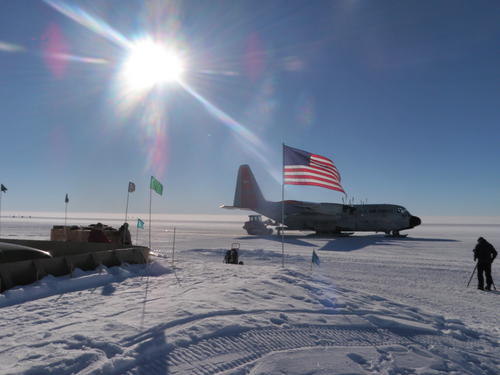
Laura Nielsen for FrontierScientists –
This week is International Polar Week, September 16 – 22, 2012. The event coincides with the Fall Equinox, when 12 hours of daylight will light every location on the planet. Polar Week aims to involve the public with research going on in the Artic and Antarctic through educational activities and engaging webinars. Do you know any students who would benefit from learning about polar science? You can find free activities and resources at the APECS Polar Week Page, including the Ice Core Art Project, talks with scientists, and other materials, activities and presentations. These approaches promote STEM (Sciences, Technology, Engineering & Mathematics) learning.
International Polar Week is supported by APECS Association of Polar Early Career Scientists, ARCUS Arctic Research Consortium of the U.S., with PolarTREC Teachers and Researchers Exploring and Collaborating, PEI Polar Educators International, IASC International Arctic Science Committee, and SCAR Scientific Committee on Antarctic Research.

–
Get started with the Ice Core Art Project. The Flakes, Blobs and Bubbles Activity examines how glaciers form. Winter snowfall accumulates and is covered over by lighter summer snow, precipitation, wind-carried dust, pollen, and ash. The cycle repeats. Over the years, lower-lying layers are compressed. Snowflakes partially melt and are squeezed together, becoming granular ice and firn (blobs) and eventually glacial ice. The ice holds bubbles of air containing atmospheric gasses from years long past.
Flakes, Blobs and Bubbles aims to teach about glacier formation and inspire art. The project will collect images of glacier components and digitally compile them into mosaics representing ice cores. It’s only one activity available from Polar Week resources; you can also create ‘glacial goo’ to simulate how a glacier moves or grow your own algae to explore methane hydrates and carbon sinks.
–
Scientists drill ice cores – long cylinders of ice – out of glaciers in order to get a picture of what Earth’s climate was like hundreds to hundreds of thousands of years ago. Ice cores contain layers of snowfall compressed into ice, as well as layers of pollen, volcanic ash, and dust (and more recently even debris from bomb testings). The detritus acts as proxies, indicating facts about climate information. The ice also holds bubbles of air that contain important information about the composition of the atmosphere in the past. Of especial importance to our modern-day dilemmas is studying concentrations of greenhouse gasses, because understanding past climate can help us gauge and predict future climate and more clearly grasp the drastic impact human activities are imposing on our modern-day climate.

Greenhouse gasses include Carbon dioxide (CO2) and Methane (CH4) which degrades into Carbon dioxide. Humans contribute to Carbon dioxide concentrations by burning fossil fuels: coal, oil, natural gas, and through other activities like deforestation. Trash breaking down in landfills, ruminant animals like cattle and sheep, and rice patties are human-influenced sources of Methane. Natural sources of Carbon dioxide and Methane like thawing or fire-scorched permafrost and plant matter decaying in warming oceans also release greenhouse gasses. Lessened sea-ice cover and retreating ice sheets lead to less sunlight being reflected away from the Earth. As temperatures and CO2 concentrations rise, each amplifies the other in a positive feedback loop.
We know that the earth experienced colder and warmer climate trends (glacial and interglacial periods) cyclically over the last 800,000 years; however, the abrupt increase in temperature and CO2 concentrations that has occurred since humans became capable of impacting global climate is both clear and disturbing.
“Antarctic ice cores show us that the concentration of CO2 was stable over the last millennium until the early 19th century. It then started to rise, and its concentration is now nearly 40% higher than it was before the industrial revolution… The fastest large natural increase [of CO2] measured in older ice cores is around 20ppmv (parts per million by volume) in 1000 years (a rate seen during Earth’s emergence from the last ice age around 12,000 years ago). CO2 concentration increased by the same amount, 20ppmv, in the last 11 years!” ~ Natural Environment Research Council
The scientists highlighted by Polar Week and by Frontier Scientists are bright minds and bold adventurers who brave polar cold to discover what is preserved in ice: information about atmospheric gasses, precipitation, temperature, and climate that can help all of us learn how to face Earth’s very real climate future.
Reference: Science briefing – Ice cores and climate change from the British Antarctic Survey Natural Environment Research Council. http://www.antarctica.ac.uk/press/journalists/resources/science/icecorebriefing.php
Frontier Scientists showcases Arctic scientists’ work. Learn about Climate Change, Professor Julie Brigham-Grette and her team drilling sediment cores at Lake El’Gygytgyn, Unmanned Aircraft Research, Computational Science + Modeling Arctic Waters, Grizzly Bears in Alaska’s Denali National Park, Arctic Archaeology, and much more.